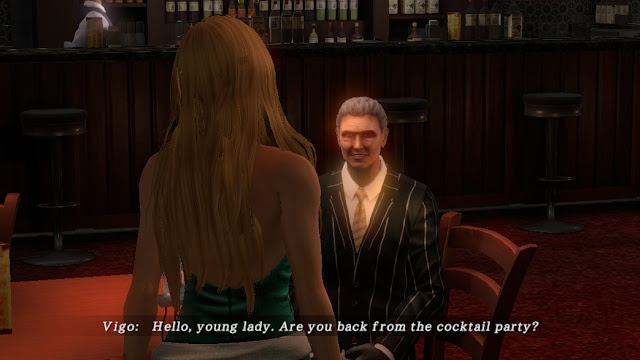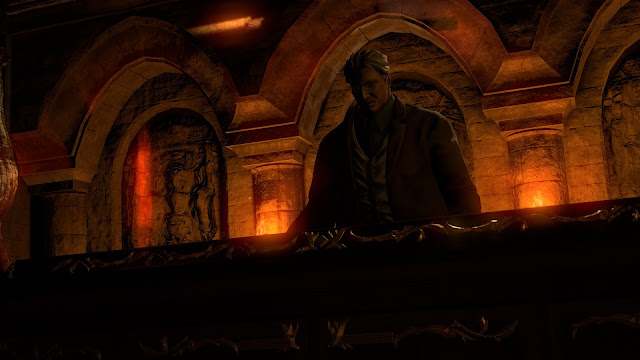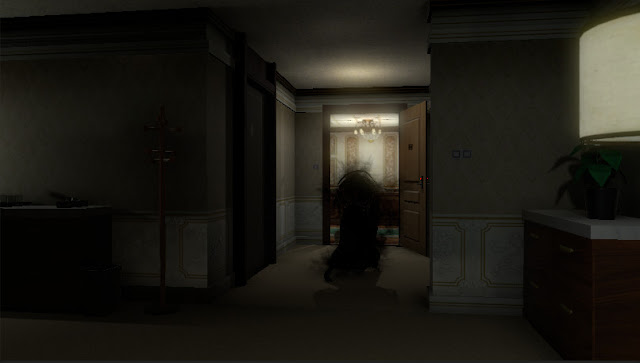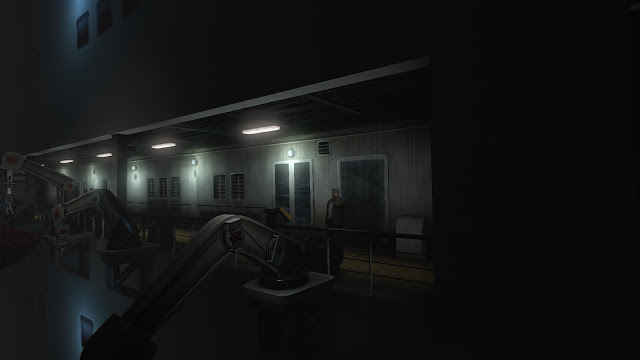Review by Harvard L.
Ladies and gentlemen, let’s have a quick talk about NightCry. Developed by Nude Maker studios and featuring talent like Hifumi Kono, the director of the original Clock Tower games, and Takashi Shimizu, the film director responsible for terrifying classics like Ju-On, among other high profile talents, NightCry is a game with substantial pedigree in alternative Japanese horror. It’s a cinematic experience very much in the vein of the original Clock Tower games where helpless people are chased down by a supernatural, teleporting murderer brandishing an enormous pair of scissors. Nude Maker craft an atmosphere of menace at every turn with each door potentially hiding the lurking killer, and the cruise liner upon which the game is set becomes more and more claustrophobic as the mysteries of the Scissorwalker come to light.
Related reading: Looking for more horror? Here’s a list of ten great horror games that we highly recommend.
Initial reactions to the game have been mixed at best; with issues in the controls and user interface holding back what many agree to be a superbly told story. When critiquing games I always try my best to be openminded about design choices and not be hasty to criticise what might be an intentional decision on the part of the developers, and oh boy is NightCry a complicated game to deconstruct. The only way I can properly do this game justice is by dividing the review into three parts: part one is my impressions of the game at face value, part two is where the game fits in with the pantheon that is horror gaming, and part three is about how historical context and the genre itself should inform the way you play NightCry. If you’re only exhibiting passing interest in this game, Part One of this review is all you’ll need to read to make a good judgement on whether this game is for you. If you’ve played the original Clock Tower games and would like to know more about the future of horror gaming as a medium, then the entire review is a journey worth going on. So let’s cut to the chase!
Part 1: Initial Impressions
NightCry is a horror adventure game which plays very much like a modernised incarnation of Clock Tower. You spend most of the game looking for clues and tools that will help you survive while avoiding a monster known as the Scissorwalker which can appear from anywhere and will chase you down relentlessly until you figure out a way to make it momentarily retreat. Like Clock Tower before it, NightCry is the video game simulation of being stalked by something powerful and terrifying.
Clock Tower is a particularly cinematic game, shown through Takashi Shimizu’s influence, leading to some truly unbelievable scares. The game uses the fixed-camera angles popularised by the PS1’s Resident Evil and many 3D adventure games. In doing this, NightCry acquires the ability to frame its scenes just like a film – it can have different types of camera shots, vectors, dynamic lighting and emphasis of objects via framing. Sound design is superb with an ambient soundtrack that is both surreal and oppressive, with sound effects and English voice acting both on point. It’s no surprise that for the most part, playing NightCry feels like watching a film.
Mechanically, NightCry is almost a visual novel in its plot progression. The game is divided up into chapters which branch based on decisions the player makes in gameplay. These are usually simple things like whether they found a plot significant object or listened to information, which then affects the outcome of later chapters. You even get a helpful story map which tells you what actions branch the story. Each chapter has you exploring a large space with relative freedom of movement – you’re not moving from Point A to Point B so much as you’re trying to find all the relevant clues and then escape. At certain points in your investigation, the Scissorwalker will appear and you will need to run away, managing your stamina and trying to find either a hiding spot or something that will deter your pursuer. Players are required to make good moral judgements as well as keep calm under pressure if they want as many characters as possible to escape alive.
NightCry is a particularly interesting horror game thanks to its cast of characters who feel like fully realised human beings. When we are introduced to the main character, she is leaving a party having tried unsuccessfully to find a date. She meets up with her friends, talks smack about one of the game’s other protagonists and always has a little extra snark to say whenever she’s examining her surroundings. Unlike a lot of horror games, NightCry takes the effort to explore its characters outside of the immediate horror context. We get a sense of what kind of people they are and can relate to them. This is also a game which isn’t afraid to get a little weird for the sake of its horror. Hifumi Kono and Takashi Shimizu perfectly understand the importance of the uncanny to create an unsettling atmosphere, and set out to do so with everything from Dutch camera angles to repeating patterns, stilted dialogue and bold lighting cues. You’ll never quite feel comfortable playing NightCry, and you should be prepared for that.
Now let’s talk downsides – the control scheme is obtrusive and unwieldy. NightCry is a point-and-click adventure game in three dimensions, and there’s no neat way to combine those two elements. You click on the ground to walk there, click on examinable objects to examine them and use objects by bringing up a small inventory menu. It gets harder when you’re being chased though, where doubletapping makes your character run, but exhausting your invisible stamina meter makes your character trip and you’re forced to be immobile for a few seconds while the Scissorwalker closes in. It’s terrifying the first time it happens, frustrating on the second and until you can estimate just when your character’s stamina is going to run out, you’ll be repeating levels a lot more than you’d like.
The pacing is also not as good as it could be. Levels are never too large but it can be confusing to figure out where you’re meant to go next. You’ll encounter logic-defying moments where you won’t be able to advance to the next room until you examine a small detail in the current one, or where examining the same thing twice will yield different results. Most of the puzzles make sense when you have all the pieces, but if you don’t know what you’re looking for you can prepare to be lost for a long time. It also doesn’t help that if you die, you get sent back via the all-too-sparse checkpoint system which will have you replaying segments at length.
This is pretty much all you need to know about NightCry at face value, so if you’re not interested in history feel free to skip to the last paragraph and the score. Everything coming up next is for context.
Part 2: What even is a horror game?
Consider this for a second – Horror is the only genre of gaming in which there are no expected game mechanics. In action games you expect to have your skill and timing tested, in shooters you shoot things and in role playing games you develop a character. But horror? You expect to be scared, and the developers will use whatever gameplay mechanics they feel appropriate to achieve that goal. That’s why the horror genre is so diverse, with everything from the action heavy Resident Evil or The Evil Within to the hide-and-wait gameplay of Penumbra to whatever Catherine and Yume Nikki do to be so freaky. Even the walking simulator has its horror moments, with the likes of Kholat and Layers of Fear appropriating the genre when you might never have thought the gameplay could possibly indulge a sense of fear.
The other unique thing about horror is that it purposefully aims for a narrow audience. Not everyone likes being scared and that’s perfectly understandable. It’s rare to stumble upon a horror game which aims to please a wide target audience, so let’s talk about the two times horror games have seen mass appeal in gaming culture.
The first was in the PSX era of the mid-90’s where polygon gaming was just hitting the scene and, for the first time ever, gaming was no longer about graphical abstractions via 2D sprites. In Resident Evil, the humans you played as looked like humans. This made it much easier for players to relate to their characters and gave games more power to affect players emotionally. Subsequently, horror gaming with its focus on audience response rather than gameplay became a defining genre in the mid 90’s with games like Resident Evil, Silent Hill, Dino Crisis, Square Enix’s Parasite Eve and even the Dreamcast’s Illbleed making waves in games stores. With fear as an immediate and visceral emotion, horror games were seen to push the boundaries of the gaming medium and thus the genre momentarily became synonymous with innovation and excitement. The second renaissance of horror gaming, if you will, is happening right now, peaking with games like Slender, Amnesia: The Dark Descent and Five Nights at Freddy’s: cheap, bite sized horror games all about the immediate scare, mostly promoted by overreacting Youtube Let’s Players. Video game budgets have steadily increased so that the older, high budget horror games have evolved into more action-oriented titles like Resident Evil 5 or Parasite Eve’s Third Birthday (or tragically being forgotten altogether like Silent Hill), leaving behind many of the horror elements to better reach the mass audience.
Nowadays for a game to get picked up by a big publisher, it needs to have this mass market appeal, or at least have developers willing to have their ideas reshaped to fit the publisher’s desires. This situation is dire in Japan right now where with the key exception of the highest profile developers, most pitches for any console game get written off as unmarketable. I can only think of the desperation of Hifumi Kono, trying to develop a creative yet niche title like NightCry in today’s video game market, which eventually led Nude Maker to try out Kickstarter. It’s through crowdfunding that NightCry was able to be developed with its original creative intent completely intact, and although the budget is nowhere near enough to satisfy the developers’ ambition (it’s a measly 300000 dollars, less than most low budget films), Nude Maker have tried its absolute hardest to make its vision a reality.
Related reading: Lindsay’s review of Layers of Fear, another point-and-click style horror game.
Part 3: Everything that NightCry stands for
I hope you see why it was so important for me to write Part 2 of this review because it helps me make my point as clearly as possible: NightCry is not a second-renaissance horror game. It’s nothing like Slender or Amnesia or even SOMA, and it doesn’t have that immediate punch that these new horror games aim for. NightCry is all about the slow brooding story, the choices the player make and their interpretation of the game’s events. It’s a horror game in the shoes of the PS1 horror renaissance where developers took their time to build, and characterise, and unfold; but with the added bonus of modern design philosophy to make a game arguably more playable than the PS1 era classics. Remember what I said about the controls? They were obtrusive and unwieldy – but I never said they were bad. They are perhaps not the best scheme to convey NightCry’s story, but put into the framework of horror gaming this scheme almost certainly makes sense. Try loading up Silent Hill on the PS1 and tell me how intuitive and empowering those controls are. No horror game is going to have perfect controls, and in fact the feeling of empowerment that come from those rare games that nearly “nail” the controls can be detrimental to the overall experience, given that taking agency away from the audience and actors is so core to fear in media. All I’m saying is that NightCry’s controls work, and I don’t think they need to do anything more than that.
The same argument can be used to justify the supposedly unintuitive level design, because examining every little nook and cranny multiple times is exactly what Nude Maker wants you to do, since appearances of the Scissorwalker are randomly triggered by interacting with the environment. The level design sets out to accomplish two things – to get the player to feel uncomfortable while exploring and to organically create scary situations, and both these systems work well.
Your enjoyment of NightCry is going to depend a lot on your perspective, which is why I suspect this is going to be one of the most divisive horror games since Deadly Premonition. To judge NightCry at face value would be to grossly overlook all the work that Nude Maker has done to create an authentic Clock Tower-style, classic stalker horror experience for the modern day. You’re going to have to look past the game’s often ugly exterior to see the beauty behind every design choice, every camera angle and every mindblowing plot twist, and you’re going to need to be a horror fan who isn’t spoiled on the modern trends of jump scares and instant gratification. The ambition and the unique vision of NightCry genuinely make me excited that there is a future in traditional gameplay. My character can run terrified down a hallway being chased by a relentless scissor wielding maniac while I sit in awe, hoping that Hifumi Kono is proud of his work.
– Harvard L.
Contributor













